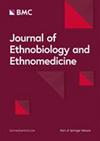不丹多个民族社区无刺蜂及其蜂巢产品的民族药用价值和文化重要性
IF 2.9
2区 医学
Q1 BIODIVERSITY CONSERVATION
引用次数: 0
摘要
不丹亚热带和温带地区的原住民和非原住民与无刺蜜蜂有着错综复杂的关系,其目的多种多样,包括民族医药用途。无刺蜂在社会、经济、文化和精神方面都具有重要意义。不丹的文化传统显示了与环境之间的紧密联系,例如经常使用无刺蜂的蜂蜜来治疗普通感冒、咳嗽和喉咙痛。我们开展了人种学研究,以记录无刺蜂在不丹的民族医药用途和文化重要性。我们采用半结构式访谈的方式,采访了无尾蜂蜂农和蜂蜜采集者,包括举行宗教仪式以治疗和预防身心疾病的传统治疗师。我们记录了无刺蜂蜂蜜在食品、医药、兽药、工艺品、信仰和宗教用途等方面的 22 种不同用途。通过计算,我们评估了无刺蜜蜂在不丹各民族社区中的相对文化重要性(RCI)。结果表明,与不丹其他族群相比,无刺蜂对洛桑巴族群的意义更大。这一发现表明印度族群在日常生活中对自然资源的依赖。所有参与研究的族群基本上都是通过破坏性的采掘方式来利用这些蜜蜂。他们通常在附近的森林中找到天然蜂巢,将其作为原木蜂巢转移到自家后院,并进行传统的蜜蜂养殖。不丹的少数民族社区将无刺蜜蜂用于各种用途,当地的知识也一直存在。然而,应做出巨大努力,从民族医药、生态、生物和商业角度研究不丹的无刺蜜蜂养殖。本文章由计算机程序翻译,如有差异,请以英文原文为准。
Ethno-medicinal uses and cultural importance of stingless bees and their hive products in several ethnic communities of Bhutan
Indigenous and non-indigenous people in subtropical and temperate areas of Bhutan share an intricate relationship with stingless bees for diverse purposes including ethno-medicinal uses. Stingless bees hold significant importance in the realms of social, economic, cultural, and spiritual aspects. Bhutan's cultural traditions demonstrate a strong bond with the environment, exemplified by the regular use of honey from stingless bees for remedies such as treating the common cold, cough, and sore throat. Ethnographic research was conducted to document the ethno-medicinal uses and cultural importance of stingless in Bhutan. We deployed semi-structured interviews with stingless beekeepers and honey collectors including traditional healers who perform religious rituals for curing and preventing physical and mental illness. We documented 22 different uses of stingless bee honey in food, medicine, veterinary medicine, crafts, beliefs, and religious purposes. The relative cultural importance (RCI) of stingless bees among Bhutan's ethnic communities was assessed through our calculations. It was determined that these bees hold notably greater significance for the Lhotshampa communities compared to other ethnic groups in Bhutan. This finding demonstrates the dependence of Hindu ethnic communities on natural resources in their everyday life. All participant communities largely exploit these bees through destructive extraction practices. They often find the natural nests in nearby forests, transfer them as a log hive to their backyards, and practice traditional meliponiculture. The ethnic communities of Bhutan use stingless bees for various purposes and the local knowledge are persistent. However, significant efforts should be made to address the ethno-medicinal, ecological, biological, and commercial perspectives of meliponiculture in Bhutan.
求助全文
通过发布文献求助,成功后即可免费获取论文全文。
去求助
来源期刊

Journal of Ethnobiology and Ethnomedicine
PHARMACOLOGY & PHARMACY-
CiteScore
7.30
自引率
16.70%
发文量
66
审稿时长
>12 weeks
期刊介绍:
Journal of Ethnobiology and Ethnomedicine publishes original research focusing on cultural perceptions of nature and of human and animal health. Journal of Ethnobiology and Ethnomedicine invites research articles, reviews and commentaries concerning the investigations of the inextricable links between human societies and nature, food, and health. Specifically, the journal covers the following topics: ethnobotany, ethnomycology, ethnozoology, ethnoecology (including ethnopedology), ethnogastronomy, ethnomedicine, ethnoveterinary, as well as all related areas in environmental, nutritional, and medical anthropology.
Research focusing on the implications that the inclusion of humanistic, cultural, and social dimensions have in understanding the biological word is also welcome, as well as its potential projections in public health-centred, nutritional, and environmental policies.
 求助内容:
求助内容: 应助结果提醒方式:
应助结果提醒方式:


